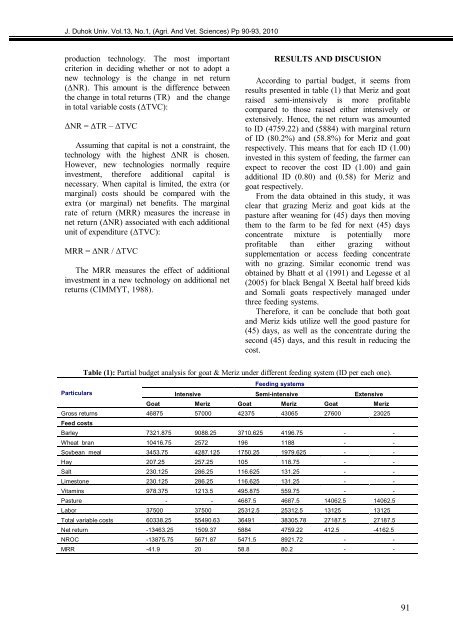The Influence Of Priming Two Cucumber Cultivar Seeds
The Influence Of Priming Two Cucumber Cultivar Seeds
The Influence Of Priming Two Cucumber Cultivar Seeds
You also want an ePaper? Increase the reach of your titles
YUMPU automatically turns print PDFs into web optimized ePapers that Google loves.
J. Duhok Univ. Vol.13, No.1, (Agri. And Vet. Sciences) Pp 90-93, 2010<br />
production technology. <strong>The</strong> most important<br />
criterion in deciding whether or not to adopt a<br />
new technology is the change in net return<br />
(ΔNR). This amount is the difference between<br />
the change in total returns (TR) and the change<br />
in total variable costs (ΔTVC):<br />
ΔNR = ΔTR – ΔTVC<br />
Assuming that capital is not a constraint, the<br />
technology with the highest ΔNR is chosen.<br />
However, new technologies normally require<br />
investment, therefore additional capital is<br />
necessary. When capital is limited, the extra (or<br />
marginal) costs should be compared with the<br />
extra (or marginal) net benefits. <strong>The</strong> marginal<br />
rate of return (MRR) measures the increase in<br />
net return (ΔNR) associated with each additional<br />
unit of expenditure (ΔTVC):<br />
MRR = ΔNR / ΔTVC<br />
<strong>The</strong> MRR measures the effect of additional<br />
investment in a new technology on additional net<br />
returns (CIMMYT, 1988).<br />
Particulars<br />
RESULTS AND DISCUSION<br />
According to partial budget, it seems from<br />
results presented in table (1) that Meriz and goat<br />
raised semi-intensively is more profitable<br />
compared to those raised either intensively or<br />
extensively. Hence, the net return was amounted<br />
to ID (4759.22) and (5884) with marginal return<br />
of ID (80.2%) and (58.8%) for Meriz and goat<br />
respectively. This means that for each ID (1.00)<br />
invested in this system of feeding, the farmer can<br />
expect to recover the cost ID (1.00) and gain<br />
additional ID (0.80) and (0.58) for Meriz and<br />
goat respectively.<br />
From the data obtained in this study, it was<br />
clear that grazing Meriz and goat kids at the<br />
pasture after weaning for (45) days then moving<br />
them to the farm to be fed for next (45) days<br />
concentrate mixture is potentially more<br />
profitable than either grazing without<br />
supplementation or access feeding concentrate<br />
with no grazing. Similar economic trend was<br />
obtained by Bhatt et al (1991) and Legesse et al<br />
(2005) for black Bengal X Beetal half breed kids<br />
and Somali goats respectively managed under<br />
three feeding systems.<br />
<strong>The</strong>refore, it can be conclude that both goat<br />
and Meriz kids utilize well the good pasture for<br />
(45) days, as well as the concentrate during the<br />
second (45) days, and this result in reducing the<br />
cost.<br />
Table (1): Partial budget analysis for goat & Meriz under different feeding system (ID per each one).<br />
Feeding systems<br />
Intensive Semi-intensive Extensive<br />
Goat Meriz Goat Meriz Goat Meriz<br />
Gross returns 46875 57000 42375 43065 27600 23025<br />
Feed costs<br />
Barley 7321.875 9088.25 3710.625 4196.75 - -<br />
Wheat bran 10416.75 2572 196 1188 - -<br />
Soybean meal 3453.75 4287.125 1750.25 1979.625 - -<br />
Hay 207.25 257.25 105 118.75 - -<br />
Salt 230.125 286.25 116.625 131.25 - -<br />
Limestone 230.125 286.25 116.625 131.25 - -<br />
Vitamins 978.375 1213.5 495.875 559.75 - -<br />
Pasture - - 4687.5 4687.5 14062.5 14062.5<br />
Labor 37500 37500 25312.5 25312.5 13125 13125<br />
Total variable costs 60338.25 55490.63 36491 38305.78 27187.5 27187.5<br />
Net return -13463.25 1509.37 5884 4759.22 412.5 -4162.5<br />
NROC -13875.75 5671.87 5471.5 8921.72 - -<br />
MRR -41.9 20 58.8 80.2 - -<br />
09



